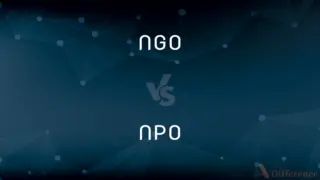Subsistence Farming vs. Commercial Farming — What's the Difference?
By Tayyaba Rehman — Published on October 9, 2023
Subsistence Farming is primarily for family consumption with little to no surplus, while Commercial Farming focuses on producing crops for sale and profit.

Difference Between Subsistence Farming and Commercial Farming
Table of Contents
ADVERTISEMENT
Key Differences
Subsistence Farming primarily involves producing crops and raising livestock to meet the daily needs of a farmer's family. On the other hand, Commercial Farming is undertaken on a large scale with the intent to sell the produce in the market for profit.
In Subsistence Farming, the size of the farm is generally small, and the main goal is self-sustainability. In contrast, Commercial Farming covers larger expanses of land, often involving modern farming techniques and machinery to maximize production.
Subsistence Farming tends to employ traditional farming methods and relies heavily on manual labor and local resources. Meanwhile, Commercial Farming often incorporates technological advancements, pesticides, and fertilizers to increase yield.
The produce from Subsistence Farming usually doesn't reach the market as it's consumed by the farming family or local community. Conversely, Commercial Farming's produce is typically destined for local, regional, or international markets, emphasizing quality and volume.
While Subsistence Farming doesn't prioritize profit and operates on a sustenance basis, Commercial Farming is driven by market demands, profitability, and often involves crop specialization based on market needs.
ADVERTISEMENT
Comparison Chart
Primary Goal
Sustenance and family consumption
Profit from selling produce
Scale
Small-scale farms
Large-scale operations
Methods Used
Traditional, manual
Modern, often mechanized
Market Orientation
Little to no market involvement
Primarily market-oriented
Focus of Production
Diverse crops for family needs
Specialized crops based on market demand
Compare with Definitions
Subsistence Farming
Farming primarily for family consumption.
Many rural families rely on Subsistence Farming to feed themselves.
Commercial Farming
Often specializes in a particular crop.
Some Commercial Farming operations focus solely on producing soybeans.
Subsistence Farming
Relies on traditional methods and manual labor.
Subsistence Farming often uses ancestral techniques passed down generations.
Commercial Farming
Large-scale and profit-driven operations.
Commercial Farming ventures often span thousands of acres.
Subsistence Farming
Not profit-oriented but sustenance-driven.
Unlike commercial ventures, Subsistence Farming focuses on survival, not revenue.
Commercial Farming
Market-oriented and responds to consumer demands.
Organic produce is gaining traction in Commercial Farming due to rising consumer demand.
Subsistence Farming
Produces minimal surplus beyond immediate needs.
In Subsistence Farming, there's rarely excess to sell in markets.
Commercial Farming
Produces crops primarily for sale.
Large orchards are common in Commercial Farming to meet market demand.
Subsistence Farming
Small-scale agricultural production.
Subsistence Farming operates on plots just large enough for family sustenance.
Commercial Farming
Uses modern techniques for maximum yield.
In Commercial Farming, drones might be used for crop monitoring.
Common Curiosities
Can Commercial Farming be organic?
Yes, many Commercial Farming operations now emphasize organic methods due to market demand.
Are there environmental concerns with Commercial Farming?
Yes, concerns include pesticide use, soil degradation, and water usage, though sustainable practices are increasingly adopted.
How does Commercial Farming differ from Subsistence Farming?
While Subsistence Farming aims for self-sustainability, Commercial Farming focuses on producing crops for sale in markets.
Why is Subsistence Farming limited in scale?
Subsistence Farming is tailored to meet a family's needs, so it doesn't typically produce a significant surplus.
Is Subsistence Farming prevalent today?
Yes, Subsistence Farming is still common in many rural and less developed areas around the world.
How do Subsistence Farmers cope with crop failures?
Subsistence Farmers often diversify crops to mitigate risks, but severe failures can lead to food shortages.
What is Subsistence Farming?
Subsistence Farming is the practice of growing crops mainly for personal consumption without a primary focus on profit.
Do Subsistence Farmers use modern tools?
While many rely on traditional methods, some Subsistence Farmers may integrate modern tools or techniques as available.
Why is mechanization common in Commercial Farming?
Mechanization helps increase efficiency, reduce labor costs, and boost yield in Commercial Farming.
Do Commercial Farms use genetically modified crops?
Some Commercial Farms use GMOs to improve yield, resistance to pests, or crop quality, depending on regulations and market demand.
How does technology impact Commercial Farming?
Technology boosts efficiency, monitoring, and yield in Commercial Farming, from machinery to software.
Is Subsistence Farming economically viable?
While not profit-driven, Subsistence Farming provides essential sustenance, but it may not generate significant income.
How do market trends affect Commercial Farming?
Commercial Farming responds to consumer demands, so market trends can influence crop choice, methods, and scale.
Can Subsistence Farming evolve into Commercial Farming?
Yes, with access to resources, markets, and capital, Subsistence Farming can transition to a commercial model.
How does land ownership differ between the two?
Subsistence Farmers often have ancestral or communal land rights, while Commercial Farmers might own, lease, or have corporate land holdings.
Share Your Discovery

Previous Comparison
NGO vs. NPO
Next Comparison
Parasite vs. PathogenAuthor Spotlight
Written by
Tayyaba RehmanTayyaba Rehman is a distinguished writer, currently serving as a primary contributor to askdifference.com. As a researcher in semantics and etymology, Tayyaba's passion for the complexity of languages and their distinctions has found a perfect home on the platform. Tayyaba delves into the intricacies of language, distinguishing between commonly confused words and phrases, thereby providing clarity for readers worldwide.












































